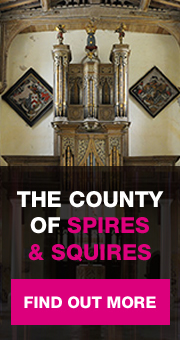One of the county’s smaller market towns with a charter granted in 1227. The parish church of St Peter and St Paul dates in this time but was largely rebuilt circa 1500. It’s spire is the first thing you see of the town when coming from the south. It stands just off the square (really a triangle) at the end of the High Street.
In the 16th century the manor here was owned by the Crown but given by Elizabeth l by the Lord Chancellor Sir Christopher Hatton (Kirby Hall and Holdenby), also from this period dates the Grammar School which with Tresham College in Windmill Road are the principle educational establishments here.
Hatton’s descendants sold the manor to the Sawyer family whose Manor House in Sheep Street is now a museum. In the 18th century Kettering was a centre of the woollen manufacturing and boasted fine buildings but these were largely destroyed in two fires, 1744 and 1766.
By the late 18th century the trade had changed initiated by Thomas Gotch’s shoe making enterprise founded in 1778. It was to be this industry which dominated the town for the next 150 years. Interestingly with these manufacturing industries came non conformity led by Thomas Toller and Andrew Falls (friend of the missionary William Carey whose Mission House is to be found near the church) – here was the Baptist Missionary Society.
The Gotch family were not only central to the leather industry here but also to the town’s architecture here. J.A. Gotch (1852 -1942) was both architect and the great authority of English Renaissance architecture. He and his later partners, Charles Saunders and Henry Surridge are responsible for numerous buildings here both civic and private.
The other artist of note was the painter Sir Alfred East and it was in his memory that Gotch built the Art Gallery in a classical style in 1913.
For those coming to the town by train you still arrive at the 1895 station in red brick, terracotta and wood barge boarding at the lower end of the town. If you strike out from here to the north east you will come to The Headlands which is a hybrid mixture of architectural styles including Gotch’s Jacobethan House built for the shoe manufacturer William Timpson in 1894 (now a school).
The Timpson factory, still operational can be found in the Bath Road. This is an interesting town to explore reflecting in its buildings the confidence of the late 19th century. Do not leave though without a visit to its most interesting 20th century development, Wicksteed Park; a public pleasure grounds in a quasi French art deco style created by Charles Wicksteed from 1918 onwards.







